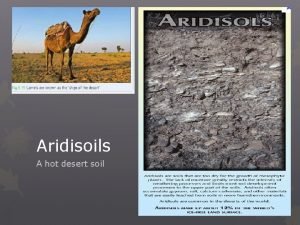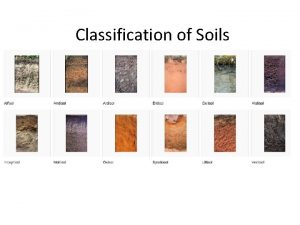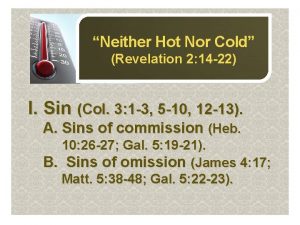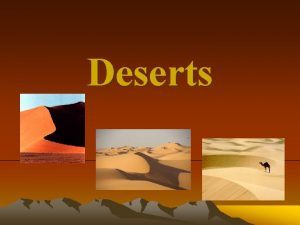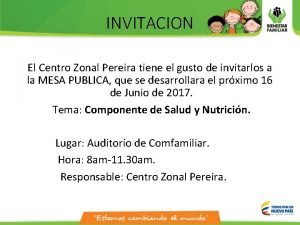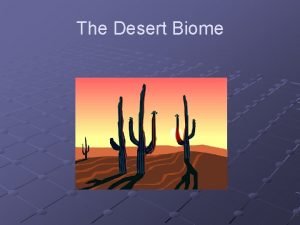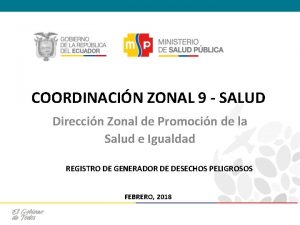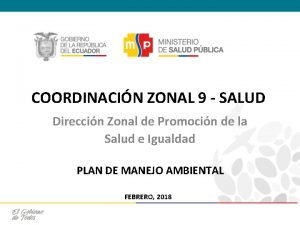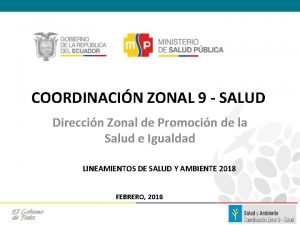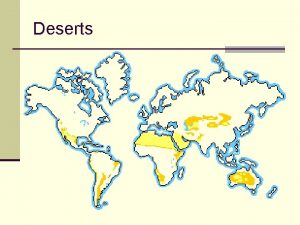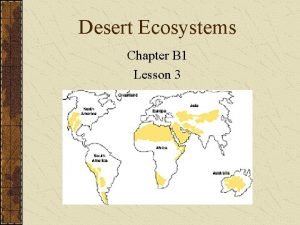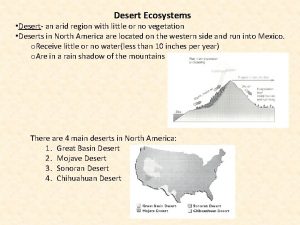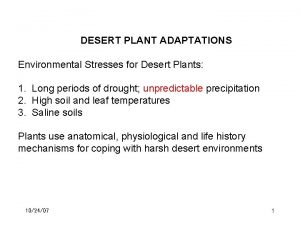Aridisoils A hot desert soil Soil Type Zonal























- Slides: 23

Aridisoils A hot desert soil


Soil Type= Zonal Soil develops in response to the desert climate. Less than 250 mm of water a year. Diurnal temperature range. High daytime 45 degrees Celsius. Night-time 0 degrees Celsius. Humidity is low. Found between 15 degree and 40 degrees North and South of the equator. Found in North Africa (The Sahel), California and Australia. Aridisols are rich in calcium carbonate. Useless for agriculture unless Irrigation is available. Occupy 12% of the earths land area.

Soil Profile


Soil Profile Develop surface pebble layers called desert pavements. Contain horizons in which clay, calcium carbonate, silca, salts or gypsum. A horizon is light in colour as little vegetation to add organic matter(humus) to the soil profile. Arid soils contain whitish layers called calcic horizons. They are a accumulations of calcium carbonate, concrete and agricultural lime. They form due to the process of calcification. They form an impermeable cement like layer of hardpan known as calcite.

Factors affecting aridisols / Soil forming factors 1. Climate 2. Relief 3. Living Things/vegetation 4. Parent material 5. Time

Climate Aridisols form in arid and semi arid regions. Annual rainfall less than 250 mm. Generally rain falls in short violent showers. Sun is high overhead and cloudless producing temperature ranges during the day between 20 to 40 degrees Celsius. Dropping to well below freezing at night. This climate causes mechanical weathering especially exfoliation ( onion weathering) creating angular scree particles for soil formation. The lack of rainfall prevents chemical weathering from occurring. Strong winds and storms can often remove fine sand particles leaving coarser and heavier soil particles behind.

Relief has a major influence on aridisols. Valleys provide pathways for flash floods which remove soils in the valley floors. Water flowing off mountainsides deposits mud, sand gravel( sediment) at the base of the slopes in huge fan shaped deposits called alluvial fans. These fans sediment are an important parent material(rock) for aridisols and influence the texture and mineral content in soils nearby.

Living things/Vegetation is scarce or absent Plants that thrive are ground hugging shrubs and short woody trees. ( Yucca, Cactus and Mesquite shrubs. They have adapted with the ability to store water. ) There is rapid growth is vegetation after the torrential downpours of rain. Plants and animals are closely linked with many animals and insects using the pants as shelter and food. However the scarce vegetation cover is limited and restricts soil building properties of micro organisms which could convert organic matter into humus. Therefore Aridisols are mineral rich but lack humus.

Parent material and Time Influences the colour of the soil. They occur on parent material such as crystalline rocks. Aridisols occur on gypsiferous material formed from marine sedimentary rocks, on unconsolidated sediments, or limestone. Desert soils that have developed on older parent material are redder in colour than soils developed on younger materials which are often pale grey.

Characteristics of Aridisols 1. Colour 2. PH 3. Humus Content 4. Structure 5. Texture 6. Water Content

Colour Some Aridisols have the same pale brownish colour. Others may be layered with browns, reds, pinks and whites. The variation in colour is due to living organisms, salinisation, weathering and parent material.

PH Aridisols have a high calcium carbonate and sodium concentrations making them alkaline( very acidic).

Humus content Contain little organic matter, therefore little humus. This is caused by a lack of plants which in turn affects the soil building properties of micro organisms that would normally convert organic matter into humus

Structure Have a blocky structure. May also be a platy structure where the clay content of the soil is higher.

Texture Have a coarse sandy or gravelly texture because there is less chemical weathering. Coarse sandy soils have large pores so they allow water to pass through (little retention). These coarse sand dust is found on lower mountain slopes. Finer dust and sand particles are blown to lower basin areas accumulating and creating a deep well drained soil cover.


Water content Low water content, these soils are very dry most of the year. This leads to very little leaching. Low water content also is related to the low humus content because of sparse organic matter. Soils without a well developed litter layer find it hard to retain water that falls on them.

Process affecting aridisols 1. Calcification. 2. Salinisation

Calcification This process involves the build up of calcium carbonate near the surface of the soil. This can happen when there is little rainfall in an area and plants pull up water (through transpiration). There is then an unequal amount of Calcium Carbonate found naturally in the soil.

Salinisation In hot areas rapid evaporation causes salts in the ground to be pulled up through the soil towards the surface. Salt on the surface builds up in a white crusty layer. Too much salt near the surface causes plants (and animals) to die. Too much salt is extremely difficult and expensive for farmers to deal with. Salinisation is the build up of salt near the surface.

 Soil layers
Soil layers Zonal classification
Zonal classification The soldier decided to desert his dessert in the desert
The soldier decided to desert his dessert in the desert Tropical desert definition
Tropical desert definition Hot dessert dihidangkan pada suhu.... *
Hot dessert dihidangkan pada suhu.... * Climate graph of desert
Climate graph of desert White hot vs red hot temperature
White hot vs red hot temperature Hot and cold working process
Hot and cold working process Perbedaan hot lava dan hot lava volcano
Perbedaan hot lava dan hot lava volcano Hot nor hot
Hot nor hot What is a desert
What is a desert Living soil vs dead soil
Living soil vs dead soil What are the four spheres of the earth
What are the four spheres of the earth Centrifugación zonal
Centrifugación zonal Centro zonal nororiental
Centro zonal nororiental Bienestar familiar santa rosa de cabal
Bienestar familiar santa rosa de cabal Centro zonal manizales 2
Centro zonal manizales 2 Centro zonal hipodromo
Centro zonal hipodromo Centro zonal manizales 2
Centro zonal manizales 2 Centrifugación zonal
Centrifugación zonal Centro zonal pereira
Centro zonal pereira Centro zonal 2 villavicencio
Centro zonal 2 villavicencio Zonal electrophoresis
Zonal electrophoresis Zonal topraklar
Zonal topraklar
